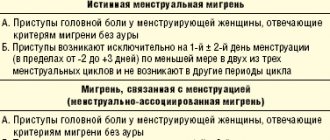Spinal osteochondrosis is a degenerative-dystrophic process that results in damage to the cartilaginous segments of the spine (intervertebral discs) with subsequent involvement of other parts of the spinal segment in the process. Due to greater mobility in the cervical region compared to other parts of the spine and a weak muscular frame, cervical osteochondrosis is observed very often - in more than 25% of cases. AND headache – one of the most common manifestations of this disease.
Clinical picture of cervical osteochondrosis
The degree of severity and nature of symptoms in cervical osteochondrosis depends on the stage of the degenerative-dystrophic process, as well as on the location of the lesion. It should be noted that there is no specific clinic for cervical osteochondrosis; the main manifestations of the disease are pain and loss of sensitivity in the neck, back of the head, shoulder girdle, arms and fingers.
Cervical osteochondrosis is almost always accompanied by headaches (cephalgia), cervicalgia (pain in the neck, radiating to the back of the head, shoulder and arms), limited mobility of the upper spine (neck and shoulder girdle), and dizziness. Depending on the damage to a particular spinal segment, headaches may be observed in different localizations, combined with numbness, short-term or long-term loss of sensation in the shoulder and arms, down to the fingers.
Causes and possible diseases
Pain in the head on the left side above the ear is a symptom of a number of diseases!
Headache is a problem for all people. The thing is that if your hand hurts, then it’s a hand disease, but if you have a headache, it can indicate any disease in the body. If pain occurs above the ear on the left, this may indicate various pathologies. Different types of pain may indicate different causes.
Let's look at the main causes and diseases that can cause headaches on the left side:
- Otitis is an inflammatory process of the ear, which can occur as a complication after an infectious disease or as an independent pathology arising due to the development of pathogenic microorganisms. In this case, severe pain occurs in the ears, radiating to the head above the ear. In addition, there are other symptoms - discharge from the ears, clicking sounds when swallowing, increased body temperature
- lymphadenitis (inflammation of the lymph nodes) is not an independent disease and occurs most often at the onset of an infectious disease
- Mumps (mumps) is an infectious pathology caused by paramyxovirus. The main symptom is inflammation of the salivary gland, which causes pain in the head above the ears. In this case, general weakness occurs and the temperature rises. This disease requires immediate treatment, as it has many complications (pancreatitis, meningitis, infertility)
- damage to osteochondral tissues and muscle mass. Most often, osteochondrosis impairs blood circulation, which impairs the supply to the cerebral cortex. This is what causes pain above the ears.
- sinusitis, rhinitis, tonsillitis, influenza - these diseases are localized in the upper respiratory tract. They affect the nasopharynx and throat. When the nerve endings are affected, the pain radiates to the head, and specifically to the ears and above.
- toothache, especially if the roots of the upper teeth are affected, pain may occur in the ears and above the ears
If there is prolonged pain in the head above the ear (2-3 days), you should consult a doctor to get examined. The doctor will prescribe a series of tests and will be able to formulate a course of treatment.
Serious reasons
Mastoiditis most often occurs as a complication of acute otitis media
Mastoiditis is one of the most unpleasant diseases that can manifest itself as a headache on the left side above the ear. The disease affects the process of the temporal bone, which is located directly behind the ear. Often the pathology develops as a complication of otitis media.
Mastoiditis must be treated, as it can develop into more serious diseases:
- a purulent labyrinth that occurs in the auditory labyrinth, in which the soft tissue begins to rot. Exposure to pathogenic microflora can lead to complete hearing loss
- Meningitis is an inflammatory process that occurs in the brain. Its consequences can be unpredictable, depending on the location of the pathology. Often, after such a disease, a person remains disabled (muteness, deafness, loss of vision, impaired coordination, memory, speech, epilepsy, etc.)
- A brain abscess is a lesion of the gray matter itself. This can cause problems, just like with meningitis. Deaths have been recorded in medicine
Due to the fact that the cause of a headache above the ear can be either an innocent cold or serious injuries, it is recommended to immediately seek help from medical professionals so that it is not too late. In the case of a serious illness, it is better to identify the pathology earlier and begin to treat it.
Another serious reason may be the appearance of a tumor in the head.
When a tumor occurs, it grows and begins to come into contact with all parts, resulting in a painful sensation.
Why is cervical osteochondrosis accompanied by headaches and dizziness?
Headaches are a very common complaint with cervical osteochondrosis. It is often accompanied by symptoms such as dizziness, poor coordination, and blurred vision. Let's consider how changes in the spinal column during cervical osteochondrosis lead to similar symptoms.
In the transverse processes from the VI to II cervical vertebrae there are canals through which the vertebral arteries pass, supplying blood to many parts of the brain and the so-called “Frank’s nerve”. Due to degenerative changes in the joints of the spine and directly in the vertebrae, the formation of osteophytes (bone growths) occurs, which leads to a narrowing of the spinal canal and compression of elements of the neurovascular system.
Osteophytes directed to the muscles irritate them, this causes a reflex muscle spasm, which leads to compression of the intervertebral discs, aggravating the course of the disease. Osteophytes, irritating the nerve roots at the exit of the spinal column, cause pain and spasms, the localization of which depends on the affected area.
Osteophytes directed to the canal of the transverse processes irritate Frank's sympathetic nerve, which leads to spasm of the vertebral artery, and also mechanically compress this artery, provoking a violation of cerebral circulation.
An acute disturbance of cerebral hemodynamics (brain circulation) leads to the development of an ischemic attack of the brain, which leads to the appearance of symptoms of cervical osteochondrosis such as dizziness, nausea, headache, loss of coordination, and blurred vision.
Another reason for compression of the Frank nerve and the vertebral artery is displacement of the disc in the posterolateral and lateral directions, protrusion of the disc into the intervertebral canal during a hernia or protrusion (protrusion of the disc without violating its integrity).
The cause of compression of the nervous and vascular structures in the cervical spine can also be subluxation of the cervical vertebrae, their confusion relative to their natural position.
In addition, muscle spasm caused by psycho-emotional fatigue, excessive physical exertion or an uncomfortable position during sleep also leads to poor circulation in the cervical region and, as a consequence, headaches and dizziness.
Possible reasons
Shooting pain in the head on the right is a symptom of many diseases. They can appear in any healthy person, in the absence of organic disorders of the nerves and blood vessels. In this case, the pain is caused by nervous tension, fatigue after physical exertion, alcohol intoxication or food poisoning. They go away after proper rest. However, headaches can be highly intense or occur with a certain frequency - these types require more detailed diagnosis.
Shooting pain in the head associated with nerve diseases
Unilateral shooting pains in the head (lumbago) are a sign of inflammation or mechanical impact on nerve fibers. On the right side is the trigeminal nerve. It innervates the soft tissues and mucous membranes of the head, upper and lower jaws, as well as the dura mater of the brain. It is represented by the fifth pair of cranial nerves. Its inflammation or mechanical impact causes attacks of neuralgia - nerve pain. It manifests itself with the following symptoms:
- shooting unilateral pain that covers half of the head, intensifies and decreases in certain positions;
- the duration of the attack is from 10 seconds to several minutes, the rest of the time discomfort may be felt along the nerve;
- additional symptoms, including nausea, dizziness, increased heart rate.
Neuritis is an inflammation of the nerve that can occur in a chronic form. Among its causes are hypothermia, decreased immune defense, especially in the off-season, injuries and mechanical pressure on the nerve. The disease requires timely treatment, as it can lead to disruption of the innervation of soft tissues and internal organs, and the membranes of the brain.
Migraine
Another cause of lumbago on the right side of the head is migraine. This is an attack of headache that occurs without an exact cause and is characterized by a certain periodicity. It is accompanied by additional symptoms that occur simultaneously with the headache or precede it. These include:
- dizziness, nausea and vomiting;
- increased sensitivity to light, lacrimation;
- decreased hearing and vision;
- numbness, deterioration of sensitivity of the fingers.
You can relieve migraine symptoms at home with painkillers. However, if this syndrome occurs frequently, specific medications are prescribed that should be taken regularly.
Cluster headaches
Cluster pain is highly intense, but is rarely diagnosed. The exact cause of their appearance remains unknown, but a vascular component is likely. Shooting pain in the head on the right or left side occurs without warning and is accompanied by additional symptoms:
- muscle weakness, drooping of the upper eyelid on one side;
- shortness of breath, which manifests itself even in the absence of physical activity;
- increased sweating, increased heart rate;
- sensitivity to bright light, lacrimation.
Cluster headaches can appear with a clear frequency, occurring at the same time over several weeks or even months. An acute attack lasts no more than 5–10 minutes, but the aching pain and discomfort then continues for several more hours.
Concussion
Impacts to the right side of the head are the main cause of closed head injuries and concussions. Falls and bruises lead to impaired blood circulation in certain areas of the nervous tissue and the appearance of signs of ischemia. The headache associated with a concussion is sharp, shooting, and very intense. Additional signs are also observed:
- blurred vision, appearance of black dots and circles before the eyes;
- nausea, vomiting;
- impaired coordination of movements;
- decreased sensitivity of the limbs;
- fainting.
Headaches can occur long after a traumatic brain injury. The time for complete recovery depends on the size of the damaged area, the age of the patient and the presence of concomitant diseases of the cardiovascular system.
Increased intracranial pressure
Periodic increases in intracranial pressure occur in most of the population, regardless of gender and age. However, it is impossible to accurately measure this indicator at home. It represents the total pressure of all fluids that are in the cranium: the contents of the cerebral ventricles, blood in the vessels, and the brain tissue itself. The diagnosis is made based on indirect signs:
- headache, which can be concentrated on the right side of the head, often has a girdling character;
- soreness in the eye area and behind the eyes, blurred vision;
- nausea, disorders of the digestive system;
- heart rhythm disturbance.
Intracranial hypertension manifests itself in attacks. It may be associated with a lack of oxygen in the room, intense physical activity, stress and tension.
Ear diseases
Otitis is an inflammation of the ear. The disease can be acute or chronic and manifests itself as pain on one side of the head. Depending on the location of the source of inflammation, external, middle and internal otitis are distinguished. Its cause is hypothermia, infectious diseases and acute respiratory viral infections, as well as injuries. It is important to treat otitis media in the early stages, since the disease is dangerous due to the addition of a bacterial component and the development of purulent inflammation. In the later stages, without timely treatment, the infection may spread to the membranes of the brain and develop meningitis.
Diseases of the cervical spine
Pain on the right side of the head can be caused by poor circulation. A common cause is diseases of the cervical spine, in which compression of the arteries supplying the brain occurs. The following disorders can be diagnosed in this area:
- curvature of the spine (scoliosis, kyphosis);
- osteochondrosis is a chronic disease in which damage to intervertebral cartilage occurs, narrowing of the space between the vertebrae and compression of blood vessels;
- spondylosis is a pathological fusion of two adjacent vertebral segments, which occurs as a result of the proliferation of bone tissue;
- intervertebral hernias are the result of protrusion of cartilage due to displacement of the vertebrae, uneven load and incorrect posture.
Shooting pain in the right side of the head is the result of a lack of oxygen in certain areas of the brain. Chronic ischemia is dangerous to health and can lead to stroke. The pain goes away after its underlying cause is eliminated.
Features of headaches in cervical osteochondrosis.
Headaches (cephalgia) with cervical osteochondrosis are usually of moderate intensity. Patients characterize the pain as dull, pulling, boring, pressing (feeling of squeezing of the head). Cephalgia with osteochondrosis is usually paroxysmal in nature (from several hours to several days).
Most often, the pain is one-sided, localized in the cervical-occipital region and spreads to the frontal and temporal regions.
Headaches with cervical osteochondrosis are often accompanied by:
- photophobia (intolerance to bright light);
- phonophobia (increased sensitivity to sounds, noise);
- feeling of stuffiness in the ear;
- complaints of blurred vision.
Stiffness in the cervical spine and muscle tension are often noted. Pain and stiffness depend on the position of the neck, and intensify with tension in the muscles of the affected side, or with prolonged stay in an uncomfortable position.
Headaches with cervical osteochondrosis are often combined with pain in the shoulder and arm.
Treatment of severe neck pain
Treatment tactics are determined based on the diagnosis and the degree of detected pathological changes. In most cases, they begin with conservative therapy, which is always comprehensive. When diagnosing spinal pathologies in such situations, the following are indicated:
- Drug therapy, including the use of drugs from such groups as NSAIDs, chondroprotectors, corticosteroids, muscle relaxants, B vitamins.
- Physiotherapy, prescribed after the acute inflammatory process has subsided and consists of undergoing 10-15 procedures of phonophoresis, UHF, magnetic therapy, ultrasound therapy, etc.
- Manual therapy, as a method of manual influence, allows you to activate tissue nutrition, eliminate muscle spasm and correct the position of the vertebrae, bringing it closer to normal and eliminating pressure on the spinal roots.
- Exercise therapy, which consists of daily systematic performance of an individually developed set of exercises that strengthens the neck muscles, activates blood flow and consolidates the results of the treatment.
If the patient is additionally diagnosed with diseases of other organs, their treatment is indicated under the supervision of specialized specialists.
It is imperative to make adjustments to your own lifestyle in order to reduce the load on the vertebrae and intervertebral discs of the cervical spine. To do this, you should regularly take breaks when doing work that requires sitting, take measures to lose weight and change your diet, eliminating harmful foods and increasing the amount of healthy ones.
In cases of severe pain that prevents the patient from leading a normal lifestyle, blockades can be performed to relieve them. They involve injections of anesthetics and corticosteroids at specific points along the spine. This allows you to quickly eliminate pain and reduce the intensity of the inflammatory process. But the effect of blockades is temporary and is a means for emergency pain relief.
However, conservative therapy is not always effective enough, especially in the presence of intervertebral hernias measuring 5 mm or more, spondylosis and vertebral compression fractures. Therefore, if it does not produce results after several months and the patient continues to suffer from severe, sharp pain in the neck, he is advised to consult a spinal surgeon to consider the need for surgical intervention.
What can provoke increased headaches with cervical osteochondrosis
- Prolonged forced positioning of the body, especially while sitting at a computer or desk.
- Uncomfortable head position during sleep;
- Sudden head movements, especially rotational ones.
- Impacts, injuries.
- Incorrectly performed massage and other manual procedures.
- Excess weight puts more stress on the spine.
- Eating spicy and salty foods does not directly worsen the headache, but leads to disruption of metabolic processes, which aggravates the disease.
How to get rid of headaches with cervical osteochondrosis
To relieve headaches, including those with cervical osteochondrosis, analgesics in combination with antispasmodics help well. For severe muscle tension and irritation, nonsteroidal anti-inflammatory drugs (NSAIDs) can be used. However, it must be remembered that these drugs do not treat the underlying disease, providing only symptomatic care, and at the same time they have a number of serious side effects. Thus, analgesics and NSAIDs, including those containing diclofenac, suppress bone marrow function, lower immunity, inhibit gastric secretion, irritating its mucous membrane and provoking the development of gastritis, and reduce blood clotting. In addition, it has been proven that systematic or frequent use of diclofenac increases the risk of heart attack by 40%, and NSAIDs in general lead to the formation of gastropathy, gum ulceration, pancreatitis and aphthous stomatitis. Antispasmodics can cause the opposite effect - increase dizziness, headache, and also cause palpitations and more complex arrhythmias.
Recently, Botox injections have been used to relieve spasms. However, botuloxin is a strong poison; in addition to the unpredictable individual reaction of the body, it can cause headaches, muscle weakness up to paresis of some muscle groups, disruption of the gastrointestinal tract and respiratory system. With each repeated use, the effect of the drug decreases.
Neuroprotectors have a prolonged (long-lasting) effect, improving metabolism in brain tissue and thereby relieving pain. However, such drugs must be taken in long courses, but if used uncontrolled, they can cause dizziness, headaches, anxiety, increased blood pressure and arrhythmia.
It is important to remember that in this case, a headache is only a symptom of the disease. In addition to symptomatic care, it is necessary to direct efforts to fight the disease itself - the spine needs to be treated.
Conservative treatment of osteochondrosis, in addition to the use of painkillers and antispasmodics, should include the use of hydroprotectors, vitamin complexes, as well as exercise therapy and physiotherapy.
Electrophoresis is the most commonly used physiotherapy procedure. Its essence is a local increase in temperature and improvement of blood circulation, which relieves muscle spasms, eliminates pain and speeds up the healing process. In general, any thermal procedures relieve muscle spasms and improve blood circulation.
Magnetotherapy involves the use of low-frequency magnetic field inductors aimed at the problem area, which leads to local dilation of blood vessels, improved oxygenation and metabolism, accelerated elimination of toxins and reduced blood viscosity. Thanks to this, magnetic therapy has an anti-inflammatory, analgesic and anti-edematous effect.
Effective assistance in the treatment of osteochondrosis of the cervical spine can be provided by a modern drug - the therapeutic pain-relieving anti-inflammatory patch NANOPLAST forte.
Treatment of cervical osteochondrosis with a therapeutic plaster NANOPLAST forte
When treating cervical osteochondrosis, the NANOPLAST forte therapeutic plaster allows you to relieve pain and inflammation, improve blood circulation in the affected area, and relieve muscle spasms. Depending on the condition and severity of degenerative changes in the spine, the drug can be used both in monotherapy and in complex treatment of osteochondrosis. The use of the NANOPLAST patch in complex treatment allows you to reduce the dose of painkillers and anti-inflammatory drugs, enhance their effect, and speed up recovery processes.
The patch combines two types of physiotherapeutic effects - deep soft heating and magnetotherapeutic properties. Long-term exposure - for 12 hours - provides a high therapeutic effect of the drug.
When treating cervical osteochondrosis, the therapeutic plaster NANOPLAST forte is applied to the disturbing area of the neck, avoiding the anterior surface, especially the area of the carotid arteries and lymph nodes. A course of treatment of 9 days or more is recommended. It is usually recommended to use the patch in the morning for 12 hours, but it can also be used at night.
High efficiency, unique composition, long-term (up to 12 hours!) therapeutic effects, ease of use and affordable price make NANOPLAST forte the drug of choice in the treatment of cervical osteochondrosis.
Read more about NANOPLAST forte









